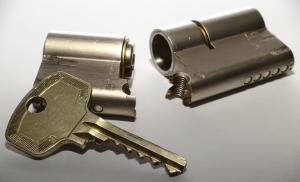What Is Lock Snapping and How to Prevent It
To many people’s surprise, one of the most common ways of breaking into a house is through the front door. Many people either forget to lock the door or are into the habit of leaving the door open intentionally, thinking they live in a quiet, crime-free neighborhood and a home burglary could never happen to them. Secondly, many people mistakenly leave a spare key under the doormat, just in case they accidentally lock themselves out, issuing an open invitation to potential neighborhood burglars.
Besides these vulnerabilities resulting from improper home security preemptive measures, many burglars employ the lock snapping technique to get relatively easy access to your home. If you are not familiar with it, keep reading. We have prepared a comprehensive guide that also includes smart preventive measures that should help you lower the risk of falling victim to this method.
What Is Lock Snapping?
Considered one of the most common home burglary techniques used by home invaders, lock or cylinder snapping refers to the procedure of snapping the cylinder lock in half. This is done by applying a certain type and amount of force. Once the snapping has occurred, it will expose the entire lock mechanism, allowing the burglar to tamper with just enough to quickly unlock the door, usually in a few seconds.
When and How Does Lock Snapping Happen?
In order for the technique to work, it must be applied to a Euro lock cylinder that extends beyond 3mm of the handle. Unfortunately, most residential and commercial properties in the US feature UPVC, aluminum, or composite doors with Euro lock cylinders, turning them into the next victim of a potential home burglary attempt.
Since lock snapping does not require any type of previous experience or special skills, but instead relies on using a screwdriver, a hammer, and mere brute force, it is commonly used by a large number of property criminals. It is a quick and quiet way of breaking into a home without being heard or seen.
A multi-locking point lock model is desirable for enhanced protection. However, since this lock is also operated by a cylinder, you will still be subject to the same type of vulnerability as the method will compromise all the locking points and render them useless.
How Common Is Lock Snapping?
Since it only takes between 5 and 10 seconds for a home invader to snap a lock, the method of attack is used in around a quarter of all home burglary cases when the owners are away from home, during the day, or at night.
The method is regarded as one of the fastest and simplest ways for burglars to gain entry to a property, especially when dealing with poor-quality locks or locks that have been subject to the wear-and-tear factor over the years.
How Can Locksmiths Help You Prevent Lock Snapping?
Provided all of your home's entries have been properly secured, an expert locksmith can inspect and assess the locks for anti-snap capabilities. When necessary, they can easily replace old and worn-down lock models that no longer suit their purposes with modern-day options with enhanced features that provide better protection. It is also possible to remove a lock, alter it to add various security alterations and reinstall it so it does not protrude outside the door to show portions usually targeted during the lock snapping.
Since burglars are constantly upgrading their home break-in tactics to suit the latest security advancements, it is critical to create as many deterrents as possible. Working closely with a professional locksmith can help you make sure that you are on top of your game all the time.
If you do not already have an anti-snap lock installed, or you need your single-cylinder, double-cylinder, or thumb-turn cylinder lock replaced, fixed, or inspected for a faulty mechanism, our pros are here to assist you.
Recommended Anti-Snap Locks
Foreseeing the vulnerability, lock manufacturers have started to develop anti-snap cylinders, giving home and business owners a variety of alternatives to choose from. All of these improved models feature cylinders with snap-off sections. These are designed to come off while a burglar is attempting to snap the lock by shortening the cylinder. This will make it a lot more difficult for the potential invader to enter the premises without a key or a different break-in method.
Despite some manufacturers claiming their products offer anti-snapping protection, it is recommended to verify if they are approved by third parties. Anti-snap lock cylinders have a one-star, two-star, or three-star rating, based on the level of security they provide.
Our experts advise you to look for a 3-Star Kitemark Logo on the lock, either to the side or on the front, to make sure you are purchasing a lock that complies with all anti-snap standards.
Euro cylinder lock models manufactured before 2011 did not benefit from this type of testing, which is why they are a lot more susceptible to this technique. The first anti-snap test standard was the Sold Secure SS312 diamond standard presented to the public in 2011. Now, the highest approval standard on a euro cylinder lock is the SS312 Diamond standard, followed by the TS007 3-star Kitemark certification. The latter should be mixed with a cylinder guard or a two-star door handle.
